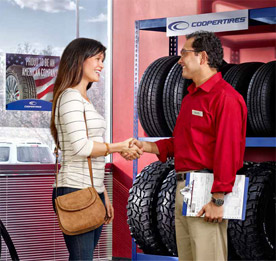Dependable Tire Shop Morris: Your Location for Top Quality Tires and Services
Dependable Tire Shop Morris: Your Location for Top Quality Tires and Services
Blog Article
Tire Solution: The Influence of Weather Condition Conditions
When it comes to ensuring ideal performance and security on the road, recognizing the influence of climate conditions on tire service is crucial. In this conversation, we will certainly discover the complex partnership in between weather problems and tire service, shedding light on the value of weather-specific tire maintenance practices and factors to consider.
Warmth and Tire Performance
When subjected to high temperatures, tires experience changes in performance that can dramatically impact lorry safety and handling. The warm produced from extended driving or heat problems causes the tire rubber to soften, leading to lowered tread life and enhanced wear. As the rubber ends up being softer, the tire's grip when driving decreases, impacting stopping ranges and total traction. In severe cases, too much warmth can also cause tire blowouts, presenting a serious safety risk to the car and its residents.
Moreover, high temperature levels can speed up the procedure of tire aging, triggering the rubber to wear away a lot more quickly. This can result in fractures, protrudes, and various other forms of damages that endanger the architectural honesty of the tire. To reduce the effects of heat on tire efficiency, vehicle drivers must regularly check their tire stress, revolve tires to guarantee even wear, and inspect for any kind of indications of damage. Furthermore, making use of tires particularly developed to hold up against heats can aid keep optimum performance and safety on the roadway.
Winter Impacts
Winter problems can have a considerable effect on tire efficiency and safety and security. As temperature levels drop, tire rubber can solidify, resulting in lowered traction on icy or snow-covered roads. In winter, tires may also lose air stress a lot more rapidly, which can influence handling and fuel effectiveness. Additionally, cool temperatures can create tire sidewalls to tense, increasing the threat of damage from fractures or various other roadway dangers.
To reduce the results of winter on tires, it is important to regularly check tire stress and inflate them to the manufacturer's suggested levels. Using winter months or all-season tires developed for cool weather condition conditions can additionally improve traction and hold on icy or snowy roads - tire shop morris. Appropriate tire upkeep, including regular evaluations for wear and damages, ends up being much more crucial during colder months to ensure ideal efficiency and security
Rainy Conditions Effect
During stormy conditions, tire performance and safety can be considerably affected by the wet road surface areas and reduced visibility. The walk pattern of tires plays a critical role in maintaining grip on damp roadways. Tires with worn-out treads are much more prone to hydroplaning, where a layer of water develops between the road and the tire surface, leading to loss of grip. To combat this, drivers ought to regularly evaluate their tires for appropriate step depth and think about purchasing tires particularly created for damp problems.

Snow and Tire Security
When driving in snowy problems, having the appropriate tires can make a significant difference in safety and efficiency. Winter tires are developed with unique rubber substances and tread patterns to supply far better grip on snow and ice contrasted to all-season tires.
Along with using wintertime tires, it is crucial to ensure they are correctly inflated. Winter can trigger tire stress to drop, affecting grip and handling (morris tire and alignment). On a regular basis checking and keeping the proper tire read more stress is crucial for optimum efficiency in snowy problems

Weather-Related Tire Maintenance
Weather-related tire maintenance encompasses a variety of practices intended at making sure ideal tire function and durability in various weather scenarios. One crucial element of weather-related tire maintenance is tire pressure law. Checking tire tread regularly and changing tires when tread wear gets to a specific deepness is essential for preserving traction and security in negative weather condition.
Conclusion
In final thought, weather problems have a significant effect on tire efficiency and safety and security (morris tire and alignment). From heat impacting tire stress and wear to chilly climate reducing traction, it is necessary to take into consideration the weather when preserving and utilizing tires.
In this conversation, we will discover the intricate connection between weather condition problems and tire solution, shedding light on the significance of weather-specific tire maintenance methods and factors to consider.

Report this page